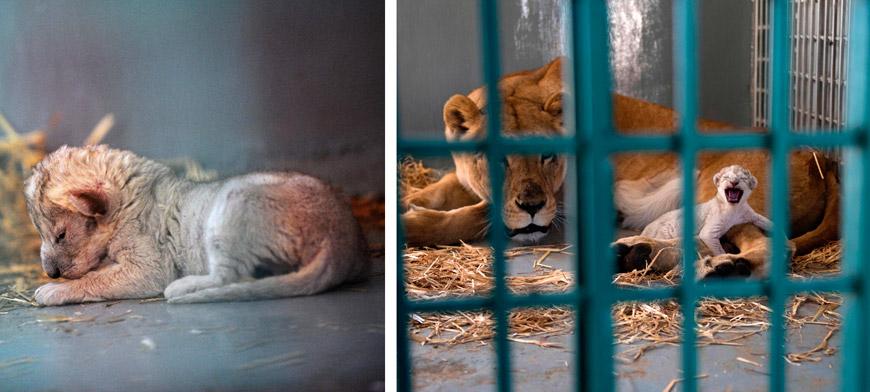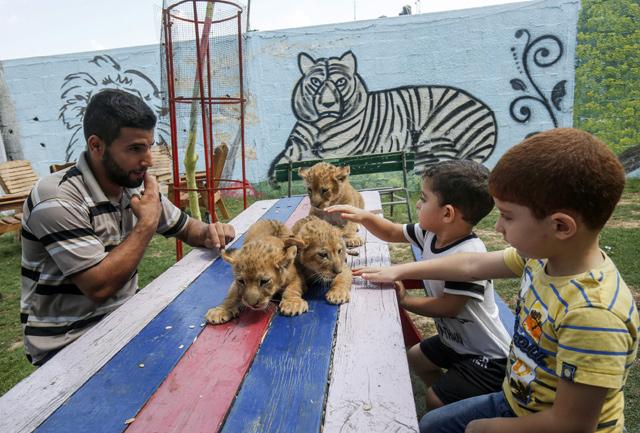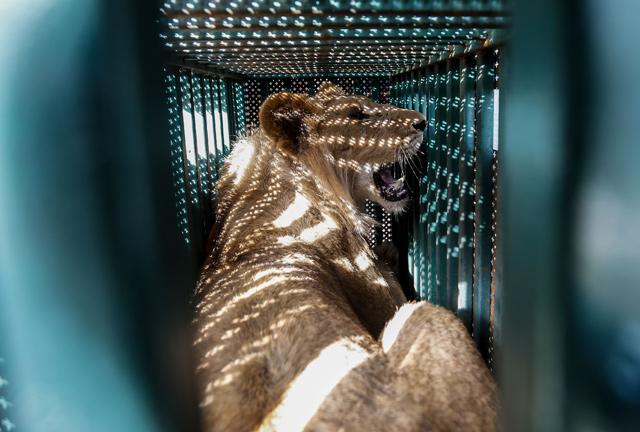You are here
Albania seeks to liberate chained bears
By AFP - Sep 24,2016 - Last updated at Sep 24,2016
TIRANA — The two five-year-old Albanian bears carry physical and mental scars from their days of mistreatment and captivity — Pashuk has marks from the tight chain on his neck, while Tomi is an alcoholic.
The pair are temporarily staying in Tirana zoo after they were rescued from their jailers, amid a new drive to liberate the Balkan country’s cruelly caged brown bears.
There are up to 250 of them roaming free in Albania’s mountains, according to the international animal rights group Four Paws. But another several dozen, between 50 and 80, were taken from the wild as cubs.
Displayed in cages in restaurants or shackled on beaches, the bears’ role is to amuse and attract tourists and well-heeled customers — who can pose with the animals for 1 euro ($1.1) per photograph.
Tomi’s former owner, who runs a restaurant 80 kilometres north of Tirana, allowed customers to serve their new furry friend beer and “raki”, the traditional local tipple.
“Coffee and alcohol, there was nothing better to wake him, as with my clients,” the businessman, aged around 40, told AFP, declining to give his name.
Tomi, who now aggressively paces up and down, will on Monday be sent with Pashuk and another female bear to neighbouring Kosovo, which has built a “bear sanctuary” after facing a similar problem.
“Tomi is always stressed and this could be explained by his withdrawal from alcohol,” said Sajmir Shehu of Four Paws.
In March, Albania’s authorities made a deal with Four Paws pledging to liberate its bears and adopt a lawmaking private possession of wild animals a crime against the environment, punishable by prison.
Until now, fines of 20 to 30 euros for keeping these animals were hardly a deterrent. But Albania wants to draw more tourists — and does not want to raise controversy over animal abuse.
Environment Minister Lefter Koka insists the time of impunity is over: “Cruelty to animals cannot be a tourist attraction.”
“We have already identified more than 50 bears in cages,” Koka told AFP.
Several of them have already been sent to parks and sanctuaries in other European countries, while two cubs are due to go to Germany.
But what about the dozens of others, who are incapable of rediscovering a fully wild life?
These animals are “stressed, passive, they bite, they have lost all reflexes to feed themselves, they are sad”, said Zamir Dedej, the director general of Albania’s Agency for Environmental Protection.
Dancing bears
“Our space is limited and we cannot keep them here long,” said Mirjam Kastrati, director of Tirana’s small zoo, which is surrounded by concrete towers.
A park would cost more than 4 million euros, an exorbitant sum for Albania, one of the poorest countries in Europe.
Koka is, however, determined to carry out his “Bear Forest” project, which he envisages in the Dajti mountain, 10 kilometres east of Tirana.
The tradition of exhibiting captive bears has a long history in the Balkans. In Serbia, a common phrase to disperse a curious crowd is: “What’s going on? Is a female bear dancing?”
Although such capture was prohibited in Albania under dictator Enver Hoxha, the period of anarchy that saw communism collapse in the early 1990s opened the door to the practice.
Nature, along with factories, was looted. Pheasants as well as eagles — the emblem of the country — have almost disappeared from the mountains. Like bears, they were officially protected. Yet, no one protested.
Koka says citizens need educating if Albania is to preserve and restore its rich wildlife — and it seems changing mindsets could take time.
“The Table of the Bear”, a chic restaurant in Tirana, draws members of the city’s elite and has welcomed former US first lady Laura Bush among its most famous guests.
Before sitting down to eat, it is fashionable to be photographed with Mark and Liza, aged 22, who for a decade have known only their cage.
Related Articles
ISTANBUL — A charity has successfully transferred 13 animals to a new home in Jordan via Turkey from a neglected Syrian zoo, including a lio
RAFAH, Palestinian Territories- A lioness is beaten with sticks while her cubs are dragged away — a Gazan zoo closed after a long campaign h
GAZA — Five lions, five monkeys, four ostriches, three peacocks, two wolves and a hyena departed Gaza for Jordan on Sunday, after being resc














